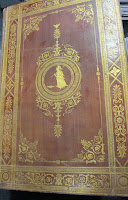Bookbindings of the Special Collections
With items dating back to the mid C15th, the aesthetics of the bookbindings in NUIG’s special collections range from simple stabbed quires to alum-tawed wooden boards, sprinkled calfskin and blind-tooled vellum, all in varying degrees of both quality and condition.
The bookbinders responsible for these works are often difficult to identify because, unlike other artists through the ages, bookbinders were considered tradesmen and rarely signed their work. With a good eye and a lot of experience, however, individual bookbinders can be discerned through the identification of ‘tools’, any decoration impressed on bindings during production. This is due to the fact that, just as bookbindings themselves were individually crafted objects during the handpress era (15th-19th century), tools were also unique to each bookbinder. It was only late in the C18th that bookbinders began to sign their work using labels (tickets) or ink, gilt or blind stamps, and these are usually to be found inside the front cover or on the front free endleaf.
An example of an exquisite unsigned binding comes from the sizeable Delargy Collection. Although its houses Snorri Sturluson’s (1179?-1241) Heimskringla, a saga of the Old Norse kings, the binding shows Athena (Minerva) and her owl within a Greek key roll frame. This phenomenon was quite common in bookbinding, and remained the case until cloth bindings in the C19th began to reflect subject matter. This item thus displays the revival of classicism in the C18th and the lavish gilding would suggest the high social standing of its former owner.
If you would like to view/ consult either item, please submit an online request or contact the staff of the Special Collections Reading Room in the Hardiman Building at specialcollections@nuigalway.ie.
The bookbinders responsible for these works are often difficult to identify because, unlike other artists through the ages, bookbinders were considered tradesmen and rarely signed their work. With a good eye and a lot of experience, however, individual bookbinders can be discerned through the identification of ‘tools’, any decoration impressed on bindings during production. This is due to the fact that, just as bookbindings themselves were individually crafted objects during the handpress era (15th-19th century), tools were also unique to each bookbinder. It was only late in the C18th that bookbinders began to sign their work using labels (tickets) or ink, gilt or blind stamps, and these are usually to be found inside the front cover or on the front free endleaf.
An example of an exquisite unsigned binding comes from the sizeable Delargy Collection. Although its houses Snorri Sturluson’s (1179?-1241) Heimskringla, a saga of the Old Norse kings, the binding shows Athena (Minerva) and her owl within a Greek key roll frame. This phenomenon was quite common in bookbinding, and remained the case until cloth bindings in the C19th began to reflect subject matter. This item thus displays the revival of classicism in the C18th and the lavish gilding would suggest the high social standing of its former owner.
If you would like to view/ consult either item, please submit an online request or contact the staff of the Special Collections Reading Room in the Hardiman Building at specialcollections@nuigalway.ie.
 |
| Gold-tooled leather binding from the Delargy Collection |
 |
| Detail |
Comments